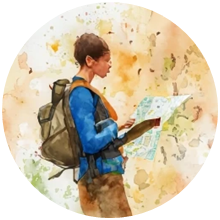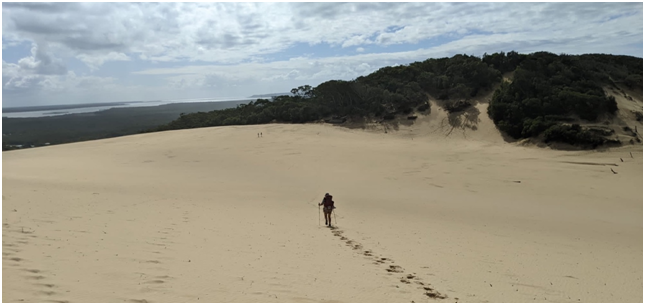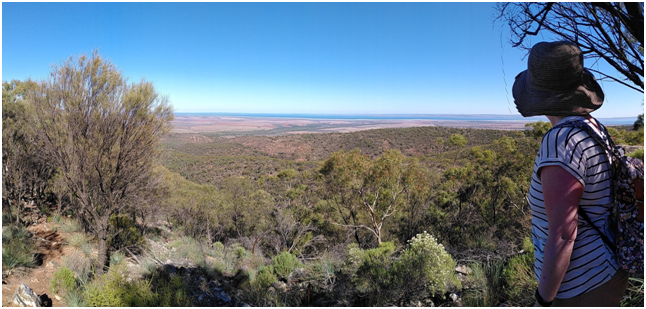A Coaching Model By Rebekah Christensen, Leadership and Life Coach, AUSTRALIA
Keep to the right side of the bay until you find the first break in the mangroves. There will be a small creek there – follow it to its source.
Visibility will probably be low and you won’t be able to see the other side. Follow magnetic bearing 340.5o until you reach the tree line.
Whenever you reach a junction in the cave, go left. This will lead you through to the other side.
These are all real instructions I have received to help me navigate my way to a particular location, along a trail, or through a complex landscape. Each represents a different technique or approach to finding your way, and each was successful.
As I’ve progressed through my coaching journey, I have seen many parallels between coaching and navigation or wayfinding. While my outdoor experience and the examples I’ve listed above might not be a common experience for everyone, the experience of wayfinding is. We all have to find our way in and around new cities, new schools or workplaces, relationships, websites, on a road trip, through complex buildings, and more. We’ve all had that feeling of disorientation and uncertainty, a need to check our bearings, seek out more information, and also the sense of satisfaction and relief upon making it to our desired outcome.
My coaching model draws upon the fundamentals of wayfinding that we all use to navigate through physical and virtual environments every day. I have adapted these fundamentals as an approach that can support the navigation of challenges, problems, and adventures throughout life. As a coach, part of my passion is to empower my clients by connecting them with their unique capabilities and creativity and supporting them to find their own way forward. I believe a wayfinding coaching model enables this to happen.
Wayfinding – A Coaching Adventure

We have all found ourselves in unfamiliar territory, feeling stuck, confused, or like we’ve lost our way.
This is where a wayfinding approach to coaching can help us plot a new course to find a way out. At its core, wayfinding, and planning for any challenge can be pared back to some simple steps:
- Know where you want to go
- Know where you are
- Plot your course
- Get your gear ready
- Plan ahead
- Get going and stay aware
Here’s what each step involves, in more detail.
Step 1 -Know where you want to go: Set your destination
The starting point for any journey is having a destination in mind. Without an endpoint, we have nothing to navigate towards.
We set a ‘destination’ for the coaching partnership by understanding what has brought our clients to coaching and what they want to achieve from the coaching partnership. What are the client’s overarching needs and goals?
Then in each session, we set a ‘waypoint’ along the journey by establishing the coaching agreement each time. In a sense, each coaching session is a micro-journey with its own micro-destination.
Questions you might hear that help to set the destination are:
- What brings you to coaching?
- What would you like to achieve from our coaching partnership?
- What would you like to talk about today?
- What would you like to take away from the coaching session?
Step 2 – Know where you are: Take your bearings
Before we can move towards our destination, we also need to assess where we are currently – to take our bearings. There are two parts to this:
- orienting in your landscape (position), and
- orienting yourself (direction).
We support a client to orient in their landscape by asking questions to explore their current situation, thoughts, and feelings. We also support them in finding some ‘high ground’ for a new perspective by asking questions and sharing observations that explore beyond their current perspective and help them to see things from a different angle.
While ‘position’ is a key part of finding one’s bearings, the second aspect of this is understanding direction. This is akin to understanding which way is up, or finding your north/south point. This part of the coaching process enables a client to go deeper into themselves and explore what is truly important to them.
There is no single north or south point for everyone. Through this part of the process we explore and identify the markers that are important to the client, the things that they want to navigate by, and that they use to guide their choices.
Questions you might hear that help to take the bearings are:
- How are you feeling about this at the moment?
- How would you like to feel?
- What’s important to you?
- What do you value?
- Who are you when you’re at your best?
- How do you want to behave?
- How do you want to make this decision?
Step 3 – Plot your course
By now, we know where we want to go, we’ve taken our bearings to know where we are, and we’ve connected with the things that will guide our choices along the journey. The next step is to plot our course.
Everyone’s course is unique – some of us will choose the scenic route, and some will take the direct route. Some of us might like to take a hot air balloon, and others to canoe down the river. The insights we uncovered in Step 2, will help the client to plot their own way forward, choosing a path that is meaningful and achievable for them.
Sometimes the client might only plot a single step forward on their journey, and that is wonderful. Wayfinding is a cycle that we can use over and over again – we can plot one step, take it, and then repeat it to find the next step.
Questions you might hear that help to plot the course are:
- How do you want to move forward?
- How can you use your insight to help you?
- What do you want to do next?
- How are you going to take action?
- What are you thinking about your next step?
Step 4 – Get your gear ready: fill up your backpack
Now we’re getting ready to move, we need to check that we’ve got the tools, supplies, and resources we’ll need for the journey. We can partner with our clients to help them explore:
- the knowledge and experience they already have that can help them,
- other knowledge or skills they want to develop,
- people or networks that are resources, and
- habits, triggers, and commitments that will support their chosen action.
If appropriate, this can also be an opportunity for a coach to offer – without attachment – resources or tools to the client, for the client to assess and choose whether or not to use.
Questions you might hear that help to get the gear ready are:
- What experience do you have that will help you move forward?
- What else would you like to know?
- How can you get what you need?
- Who can help you?
- What will help you stay focused?
Step 5 – Plan ahead
At this stage of things, we’re usually feeling energized and excited to get out on the trail. But even with careful planning, there’s a good chance that any journey will encounter unexpected challenges or detours along the way. We increase our chance of reaching our destination if we plan ahead to consider the risks, how we’ll monitor progress, and how we’ll reorient or recover if we lose our way.
Questions you might hear to support planning ahead are:
- How will you hold yourself accountable to your action plan?
- What will help you keep your direction?
- How will you keep track of your progress and celebrate it?
- What could get in the way?
- How will you get yourself back on track if you get stuck?
- How can your new learning help you?
Step 6: Get going and stay aware
This is the most exciting part when the client takes action and moves forward in the direction of their destination. As the client steps into their journey, it’s important for them to stay aware of themselves and their surroundings. The insights uncovered in Step 5 can support this, and help the client to track their progress, stay or get back on track, and have opportunities to learn from their experiences.
We don’t need – and indeed will rarely have – full visibility or certainty of the entire path ahead on any journey. A wayfinding approach to coaching can help set our clients up for success and is a process that the client can use to help them stay on course, reorient, and/or re-plot their course when they’re out on their journey.
Wayfinding is an iterative cycle and something that the coach and client can return to in their partnership to develop additional layers of insight and learning for the client. In doing this, the client can plot steps that join to become pathways, that in turn weave together to create a rich and meaningful map of life adventures.
So come on, let’s go!

Learn How to Create Your Own Coaching Model
Your Coaching Model reflects your values,
philosophies, and beliefs and must communicate who you will coach
and the problems you will solve. Read more about creating your coaching model
References
- Epstein, RA, Patal, EZ, Julian, JB, Spiers, HJ (2017) The cognitive map in humans: Spatial navigation and beyond.Nature Neuroscience 20(11): 1504-1513. Doi:10.1038/nn.4656.
- Lidwell, W, Holden, K Butler, J (2010) “Wayfinding”. The Pocket Universal Principles of Design: 125 Ways to Enhance Usability, Influence Perception, Increase Appeal, Make Better Design Decisions, and Teach through Design. Rockport Publishers. p. 260. ISBN 9781610580656
- Low, S (2019) Hawaiki Rising: Hōkūle‘a, Nainoa Thompson, and the Hawaiian Renaissance. University of Hawaii Press. ISBN 9780824875244
- O’Connor, MR (2019) Wayfinding: The science and mystery of how humans navigate the world. Affirm Press. ISBN 9781925712759
- Symonds, P. What is wayfinding? https://www.travelwayfinding.com/what-is-wayfinding/
Image credits:
Photo on page 1, courtesy of I Murchland
The image on page 3 was generated using Craiyon: https://www.craiyon.com/
Photo on page 6, courtesy of S Phinn
